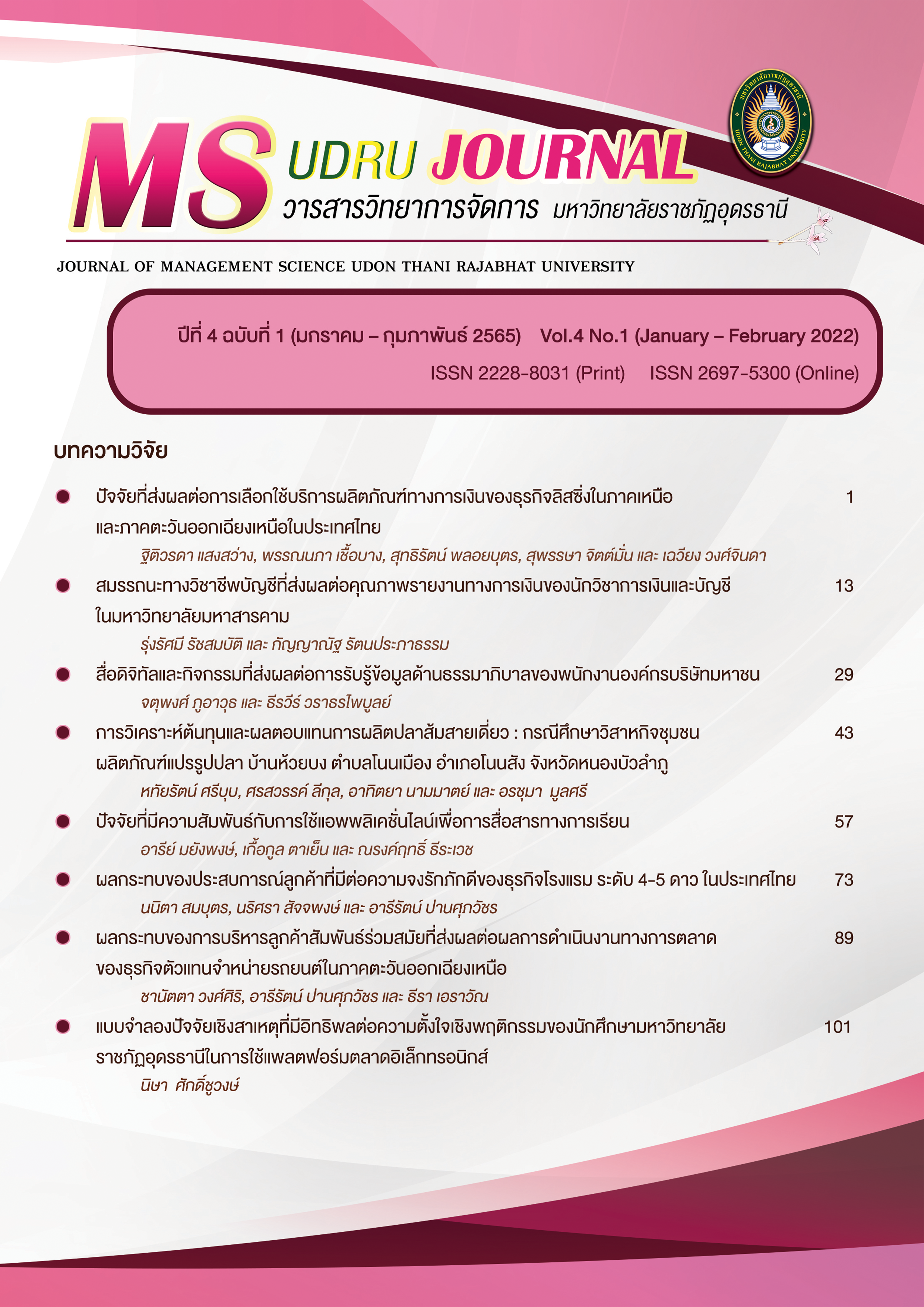FACTORS RELATED TO UTILIZATION OF THE LINE APPLICATION FOR THE LEARNING COMMUNICATION
Main Article Content
Abstract
The purposes of this research were 1) to study the behavior of using the LINE application, 2) to study the level of perceiving features of the LINE application, attitudes and social influence on the use of the LINE application and the use of the LINE application for learning communication and 3) to analyze factors related to utilization of LINE application for students’ learning communication of Rajamangala University of Technology Phra Nakhon. The quantitative approache was applied by using a questionnaire for data collection. The research sample were 380 students of Rajamangala University of Technology Phra Nakhon. Descriptive statistics were used; percentage, mean, standard deviation, and pearson correlation coefficient. The finding found that the most of the students’ use of LINE application had more than 5 years of experience, the purpose of using was to chat with friends in the class, the average duration of use each time was less than 30 minutes, the number of application on average was 6-10 times a day, and mostly used on smartphones. The students expressed their views of the perceiving factors of LINE application; attitude, social influence on the use of LINE and the use of LINE for the communication of students’ learning was at a high level. All three factors were related to utilization of LINE application for students’ learning communication in a moderate level and they were in the same direction.
Article Details

This work is licensed under a Creative Commons Attribution-NonCommercial-NoDerivatives 4.0 International License.
บทความที่ได้รับการตีพิมพ์เป็นลิขสิทธิ์ของคณะวิทยาการจัดการ มหาวิทยาลัยราชภัฏอุดรธานี
ข้อความที่ปรากฏในบทความแต่ละเรื่องในวารสารวิชาการเล่มนี้ ไม่ใช่ความคิดเห็นและความรับผิดชอบของผู้จัดทำ บรรณาธิการ กองบรรณาธิการ และคณะวิทยาการจัดการ มหาวิทยาลัยราชภัฏอุดรธานี ความรับผิดชอบด้านเนื้อหาและการตรวจร่างบทความแต่ละเรื่องเป็นความคิดเห็นของผู้เขียนบทความแต่ละท่าน
References
จันจิรา แก้วขวัญ. (2561). พฤติกรรมการใช้เครือข่ายสังคมออนไลน์อย่างเหมาะสมของนักเรียนมัธยมศึกษา อำเภอเมืองสงขลา จังหวัดสงขลา. วิทยานิพนธ์ ศิลปศาสตรมหาบัณฑิต ภาควิชาจิตวิทยาและการแนะแนว บัณฑิตวิทยาลัย มหาวิทยาลัยศิลปากร.
จุฑารัตน์ ศราวณะวงศ์ และคณะ. (2560). พฤติกรรมการใช้สื่อสังคมออนไลน์ของนิสิตระดับปริญญาตรี มหาวิทยาลัยเกษตรศาสตร์. วารสารบรรณศาสตร์ มศว, 10(2), 17.
ธนะวัฒน์ วรรณประภา. (2560). สื่อสังคมออนไลน์กับการศึกษา. วารสารศึกษาศาสตร์ มหาวิทยาลัยมหาสารคาม, 11(1), 14.
ธานินทร์ ศิลป์จารุ. (2560). การวิจัยและวิเคราะห์ข้อมูลทางสถิติด้วย SPSS และ AMOS.กรุงเทพฯ: เอส. อาร์. พริ้นติ้ง แมสโปรดักส์.
บุษบา ทาธง และคณะ. (2562). ผลของการจัดการเรียนการสอนโดยประยุกต์ใช้แอพพลิเคชั่นไลน์ต่อผลลัพธ์การเรียนรู้และความพึงพอใจของนักศึกษาพยาบาลศาสตร์บัณฑิต ในรายวิชาการพยาบาลบุคคลที่มีปัญหาสุขภาพ 1 วิทยาลัยพยาบาลบรมราชชนนี ชัยนาท. วารสารวิทยาลัยพยาบาลบรมราชชนนี อุตรดิตถ์, 11(1), 165.
มานน เซียวประจวบ และนิษา ศักดิ์ชูวงษ์. (2562). การพัฒนาตัวบ่งชี้ปัจจัยที่กำหนดการยอมรับเทคโนโลยีชำระเงินผ่านช่องทางออนไลน์ของผู้บริโภคในจังหวัดอุดรธานี. วารสารวิทยาการจัดการ มหาวิทยาลัยราชภัฏอุดรธานี, 1(1), 4.
วสุธิดา นุริตมนต์ และทรงวิทย์ เจริญกิจธนลาภ. (2561). ปัจจัยที่มีอิทธิพลต่อการยอมรับเทคโนโลยีและความตั้งใจใช้บริการชำระเงินของผู้บริโภครุ่นใหม่ด้วยโปรแกรมประยุกต์คิวอาร์โค้ดผ่านโทรศัพท์เคลื่อนที่. วารสารวิชาการนวัตกรรมสื่อสารสังคม, 6(2), 41.
วัชรวิทย์ นันจันที. (2558). LINE FOR INSTRUCTION ไลน์ ทางเลือกใหม่เพื่อการเรียนการสอน. สืบค้นเมื่อ 16 มิถุนายน 2563, จาก http://lineforinstruction.blogspot.com/
วิธวินท์ อัตถปรัชญาเมือง. (2562). สถิติผู้ใช้ของ LINE ประเทศไทยในปี 2019. สืบค้นเมื่อ 26 พฤษภาคม 2563, จาก https://www.thumbsup.in.th/line-th-stats-2019
ศักรินทร์ ตันสุพงษ์. (2557). ปัจจัยที่ส่งผลต่อการยอมรับแอพพลิเคชั่นไลน์. การค้นคว้าอิสระหลักสูตรวิทยาศาสตร์มหาบัณฑิต สาขาวิชาเทคโนโลยีสารสนเทศและการจัดการ มหาวิทยาลัยกรุงเทพ.
สำนักงานคณะกรรมการพัฒนาการเศรษฐกิจและสังคมแห่งชาติ สำนักนายกรัฐมนตรี. (2560). สรุปสาระสำคัญ แผนพัฒนาเศรษฐกิจและสังคมแห่งชาติ ฉบับที่ 12 (พ.ศ. 2560-2564). สืบค้นเมื่อ 15 ธันวาคม 2562, จาก http://www.library.coj.go.th/Info/48341
สำนักส่งเสริมวิชาการและงานทะเบียน มหาวิทยาลัยเทคโนโลยีราชมงคลพระนคร. (2562). สรุปสถิตินักศึกษาแยกตามคณะกลุ่มสังคม-วิทย์ ประจำปีการศึกษา 2562. สืบค้นเมื่อ 26 มิถุนายน 2562, จาก http://regis.rmutp.ac.th/wpcontent/uploads/2019/12/
Bogart, W. D., & Wichadee, S. (2020). Exploring Students’ Intention to Use LINE for Academic Purposes Based on Technology Acceptance Model. Retrieved January 15, 2020, from http://www.irrodl.org/index.php/irrodl/article/view/1894/3344.
Kivunja, C. (2015). Teaching, Learning and Assessment: Steps towards Creative Practice. Retrieved January 15, 2020, from https://www.scirp.org/reference/ReferencesPapers.aspx?ReferenceID=1614158.
White, A. R. (2017). User Acceptance of the Line Application in an Educational Context. In CreTech 5th International Conference on Creative Technology, pp. 19-21 Bangkok, Thailand.
White, C. M. (2012). Social media, Crisis communication, and Emergency management: Leveraging Web 2.0 Technologies. Boca Raton: CRC


